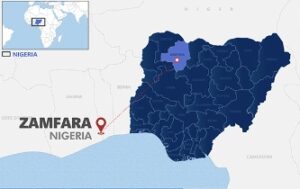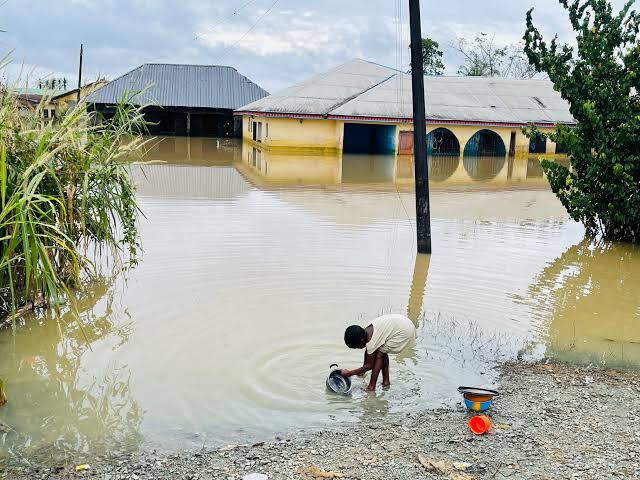In the wake of intense rainfall over the past few weeks, Gummi Local Government Area in Zamfara State is grappling with a devastating flood crisis. The aftermath has left over 10,000 people displaced and destroyed farmlands and other properties worth millions of naira. The calamity, which has left communities reeling, was highlighted by the Emir of Gummi, Justice Hassan Lawal (retired), during a visit by Zamfara State Governor Dauda Lawal to the affected areas.
Governor Dauda Lawal, showing concern for his people, made an on-the-spot assessment visit to Gummi town and the neighboring Gayari community to evaluate the extent of the flood damage. His visit marked a significant show of support, as it followed the dispatch of three delegations by the state government to the area earlier.
During the briefing, Justice Lawal, the Emir of Gummi, provided a grim breakdown of the current situation. He revealed that a total of 10,291 households had been severely impacted by the floods. The emir further noted that discussions with experts indicated that a permanent solution could be found to prevent such disasters in the future. “For the assessment, 10,291 households were affected but we understand that the governor will go round to see for himself,” Justice Lawal stated, underlining the gravity of the situation.
 Governor Lawal expressed his sympathy for the flood victims and announced an immediate relief package to provide some solace. The governor promised an allocation of N100 million, along with the distribution of 10,000 bags of assorted grains, including rice, maize, and millet, to help those who had lost their homes and livelihoods. He also assured the affected communities of mosquito nets and blankets to alleviate some of the immediate discomforts faced by the displaced families.
Governor Lawal expressed his sympathy for the flood victims and announced an immediate relief package to provide some solace. The governor promised an allocation of N100 million, along with the distribution of 10,000 bags of assorted grains, including rice, maize, and millet, to help those who had lost their homes and livelihoods. He also assured the affected communities of mosquito nets and blankets to alleviate some of the immediate discomforts faced by the displaced families.
“Today, I am in Gummi local government area to offer my condolences and conduct an on-the-spot assessment of the communities devastated by flooding caused by heavy rainfall last week,” Governor Lawal stated. His visit and the announcements of support were received warmly by the affected residents, who have been enduring harsh conditions since the flooding began. The relief materials, according to the governor, were already en route to Gummi for prompt distribution.
To address the long-term challenges posed by flooding, Governor Lawal outlined plans to construct new drainage systems, repair existing dams, and possibly build additional ones. This multi-pronged approach aims to enhance flood management infrastructure and prevent future occurrences.
Community Response and Government Commitment
The flood’s impact has been profound, with numerous residents now homeless. One resident expressed relief and gratitude for the governor’s visit, stating, “We are happy to see the governor visit us. This shows he cares for us. Two-thirds of the people in this community are now homeless because of the flood. For the governor to come and see the situation, that alone has given us hope.” Many of the displaced are currently seeking refuge in government buildings, schools, and even a petrol station, highlighting the scale of the displacement.
In a bid to ensure that the relief efforts are properly managed and reach those in need, the Zamfara State Government has set up a committee led by an elder statesman, Alhaji Salihu Maibuhu Gumi. This committee will oversee the distribution of relief materials and ensure that the affected individuals receive necessary assistance.
National Flooding Crisis: A Growing Concern
The situation in Zamfara is part of a broader crisis affecting several parts of Nigeria. According to the National Emergency Management Agency (NEMA), at least 179 people have died, and more than 200,000 have been displaced due to flooding across the country. The most severe flooding has been reported in the northern regions, with significant damage also anticipated in central and southern parts as the rainy season continues.
NEMA’s figures indicate that approximately 107,600 hectares (265,885 acres) of farmlands have been affected, which threatens food security in the region. The agency’s spokesman, Ezekiel Manzo, cautioned that communities along the Niger and Benue rivers are at higher risk. He further warned that as water from the northern regions flows southward, the central and southern parts of Nigeria could experience even more severe flooding.
Flooding, a recurring problem in Nigeria, is often exacerbated by heavy rainfall and inadequate infrastructure. In recent years, the country has witnessed devastating floods. In 2012, over 360 people lost their lives, and more than 2.1 million were displaced. The 2022 floods, the worst in a decade, resulted in over 500 deaths and displaced 1.4 million people.
**Federal Government’s Response**
President Bola Ahmed Tinubu has acknowledged the gravity of the situation, stating that the federal government will issue timely warnings to mitigate the impact of such environmental disasters. NEMA has also developed contingency plans to prevent a recurrence of the current crisis. “We don’t have time to waste any longer so people will not be caught unaware,” Manzo emphasized, highlighting the urgency of the government’s response.
As the rainy season progresses, the authorities are urging citizens, especially those in flood-prone areas, to heed warnings and take necessary precautions. The situation remains fluid, and continuous efforts are needed to manage the crisis and support the affected populations effectively.




